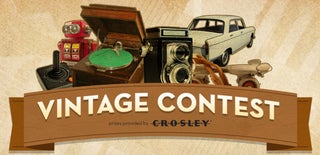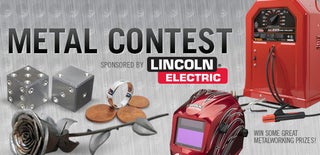Introduction: Vintage Inspired Stereo
This project started with the purchase of an old am/fm receiver. I bought it from a thrift store in a spur of the moment decision just because I thought it was cool, not really having any plans for it. Then the brainstorming began and this is what I came up with. I wanted to keep the vintage look using modern components so it would look and sound great. I decided to add a vintage looking radio tower to the top for some extra flare and to attach an extra larger speaker. So if you're looking for your own vintage stereo with modern components, lets get to it...
Step 1: Stuff You Need
Things You'll Need: (This is what I used, you may want/need to tweak the components based on what your needs and what kind of old radio you find)
- Some sort of vintage radio, check around your local thrift stores or ebay (it doesn't have to be working)
- 50 watt amplifier
- Lanzar 6.5" midbass speaker
- Two 4" speakers (make sure they will ft on the sides of your vintage radio)
- 24 VDC power supply
- RCA to auxillary cable
- Metal rods (can be found at home depot)
- JB quick weld
- 4 drywall screw anchors
- red flashing LED bulb
- red LED bulb
- wire
Tools You'll Need:
- Jigsaw
- Drill
- Wire cutter
- Soldering iron
- Solder
- Electrical tape
Step 2: Prepare Your Vintage Radio to Use
The first thing you'll want to do is disassemble your vintage radio. Keep all the components in a box because you may end up using some of them later.
After your vintage radio is empty, you'll need to drill in your drywall anchors into the top. These will act as the base to hold the radio tower in place and provide it with a solid foundation. My anchors are placed about 6" wide and 4 1/2" deep. This allowed me to attach the speaker about half way up the tower.
Step 3: Wire Up the Blinking LED
You'll want to glue in your blinking LED to the top of your radio tower but you'll need to wire up your LED first because it is hard to access after it's glued in. To do this simply solder a wire onto each contact of the LED and wrap it in electrical tape.
I used an LED holder for mine but I think it might be easier to attach to the tower without the holder so it's up to you.
Step 4: Glue Your Radio Tower Together and Attach the Speaker
This step is quite a process because you need to glue your tower together in sections and wait for it to dry until you can move on. It may take a day or two to complete but you can go on your merry way while the glue is drying so it doesn't take up too much time.
You'll first want to cut your metal rods that run vertical on your tower. I cut each of mine to 18" in length. To glue them together, place the base of each rod in the drywall screw anchors in the top of your vintage radio. Then lean all the rods together at the top with the blinking LED in the middle. Mix together your JB weld and apply to the joint at the top. Let this sit for 4-6 hours until it is completely set.
Next you'll want to add a horizontal support to your tower. To do this measure out each piece you'll need and then glue them in a square separately from the tower. Let that dry completely and then glue it to the bottom of your tower.
Next you'll want to attach your speaker to the tower. Place the speaker face down with the tower on top of it and glue the speaker on to the tower. Try to cover as much surface area as possible on the speaker and tower with the glue to increase the holding strength.
After that has dried, continue to glue on 3 more horizontal supports until you are satisfied with the look of your tower.
Step 5: Mount Your Smaller Speakers
Next you'll want to mount the two 4" speakers to the sides of your vintage radio. Use a jigsaw to cut out the holes and then attach your speakers.
Step 6: Mount the Amp and Power Supply
I had to cut out a new back for my radio because the old one wasn't in great shape. I then glued a hinge to the back and the radio. This allowed me to mount the amp on that back piece of wood and still connect the wires easily.
So next, drill some holes and use bolts and nuts to attach your amp and power supply. You can see in the photos how I configured mine and it worked great that way but feel free to experiment anyway you want.
Step 7: Wire It All Up
Now it's time to wire it all up! I was able to use the existing power switch from the radio which I thought was cool. To do this you're going to need to use a tester to find the inputs and outputs. If you can't figure it out, don't worry, just add another power switch somewhere.
So the wiring is pretty basic. It goes from the power supply, to the switch, and then out to your amp and LEDs. Then connect your speakers to the amp and plug in your RCA cable.
Plug it in to the wall and connect the auxiliary plug to your input device (I use mine as computer speakers) and if all went well you should hear music!
Step 8: The Finished Product
You're done! Crank that bad boy up, bask in the glory of what you have made, and have a dance party to celebrate!
I'm really happy with what I made. It looks awesome sitting on my desk and sounds pretty good. The bass doesn't hit extremely hard because the bigger speaker isn't in a proper box but it's not bad at all. Overall, it's a really fun creation that is always a conversation starter and is actually useful as a decent set of desktop speakers.
I hope you enjoyed my creation and I inspired you to create something similar. Check out my website to follow me and check out more projects like this at travsdesk.com and follow me on Instagram @travderose and Vine at Trav DeRose
-Trav

Participated in the
Vintage Contest

Participated in the
Home Technology Contest

Participated in the
Metal Contest













